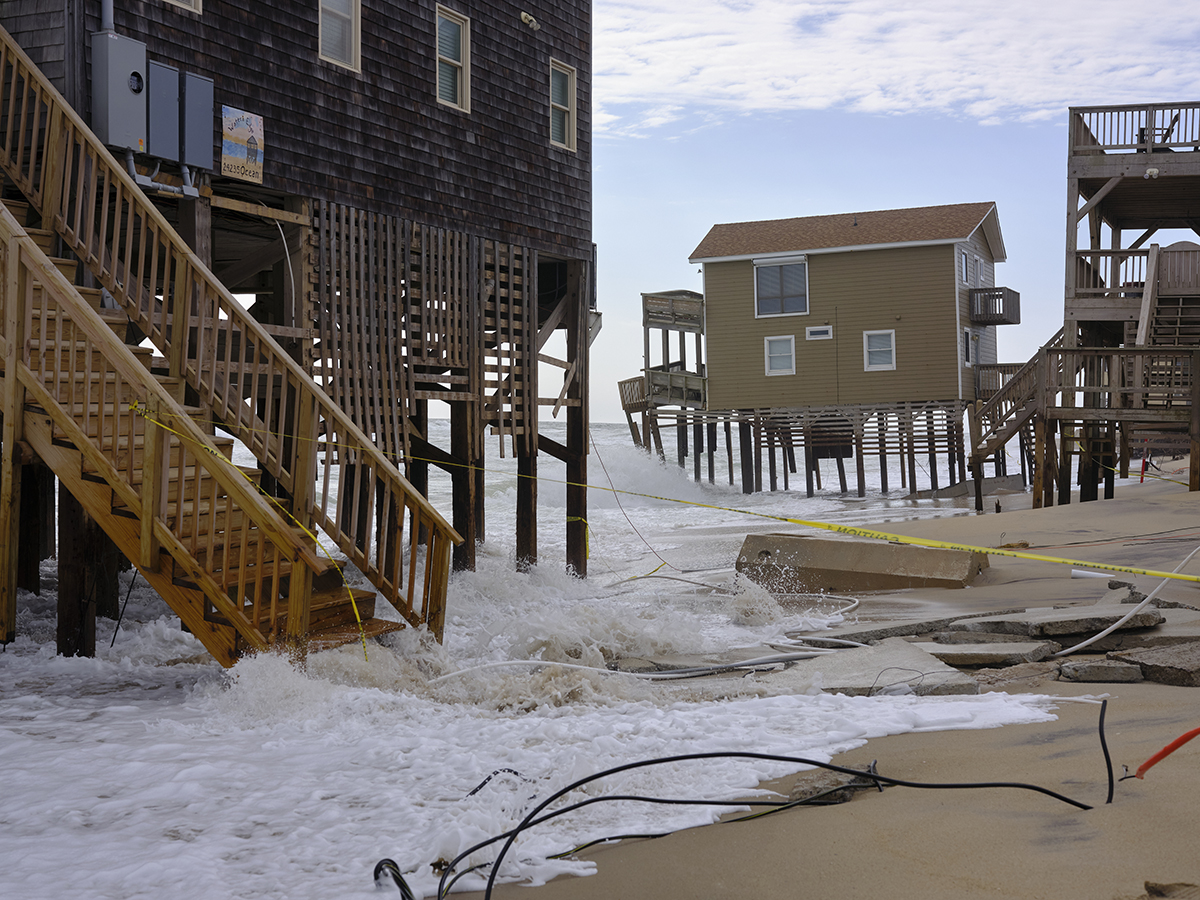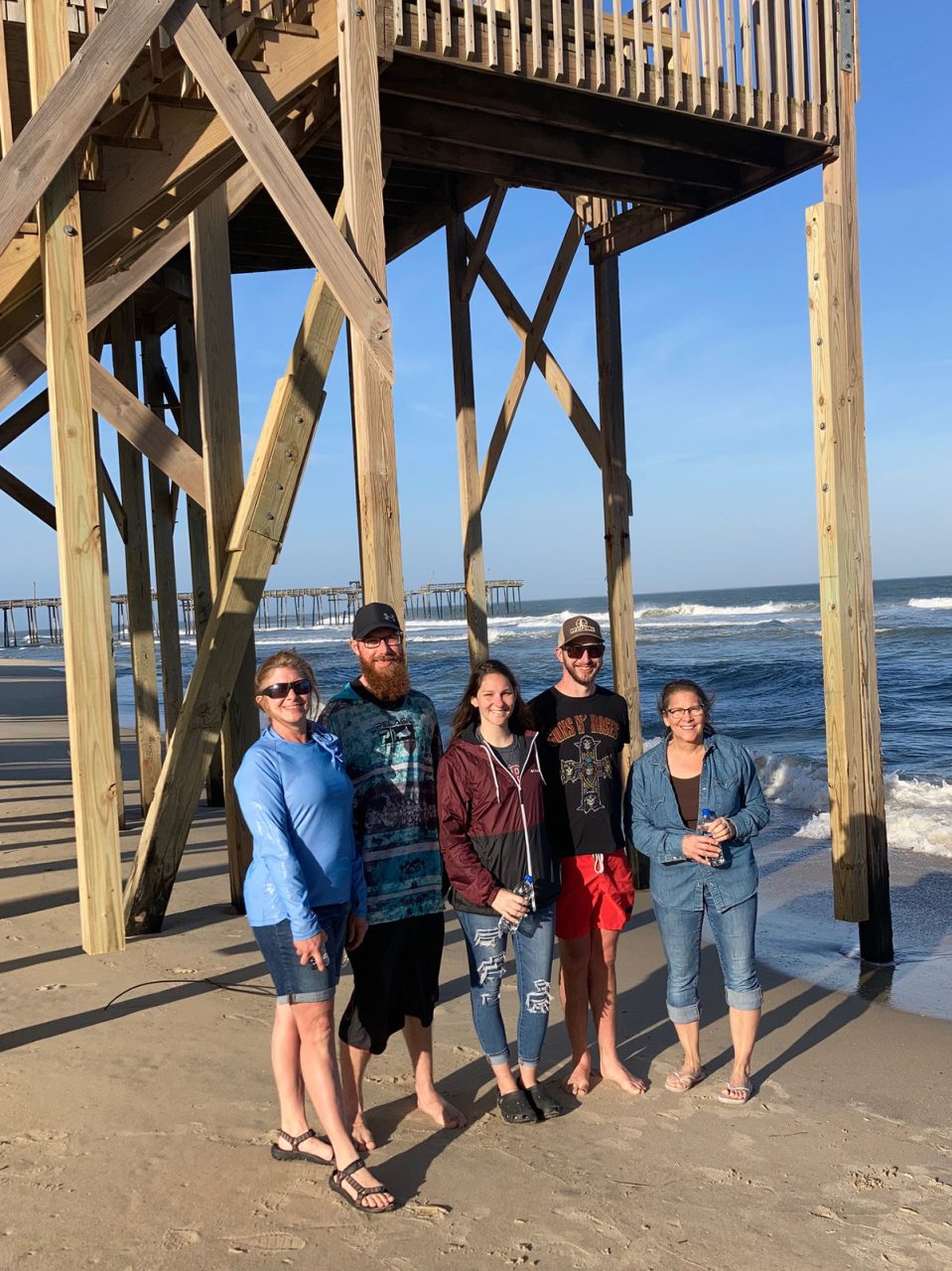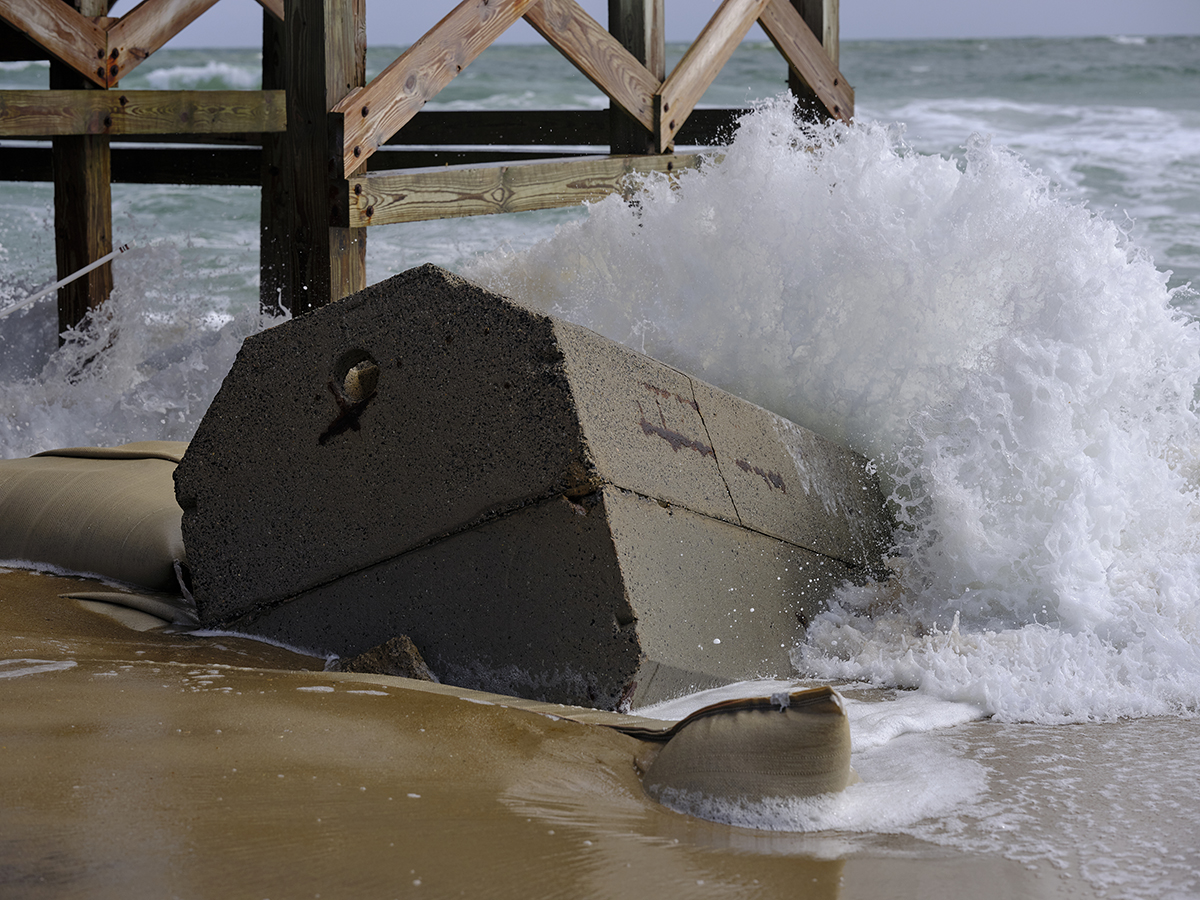
RODANTHE — It was a warm and breezy late winter afternoon, a perfect day for a stroll along the ocean. As seabirds dove for dinner just offshore, Hope Lineman and her family were working their way north, weaving between a stretch of large houses on the beach off Ocean Drive. But they weren’t there to watch the waves; they were there to see the devastation wrought by waves.
And like nearly all who see looming destruction on the eroded beach, they wonder why no one is trying to prevent it.
Supporter Spotlight
Weeks before, early on the morning of Feb. 9, one of the houses here had collapsed into the Atlantic. Soon photographs of the ruins filled national news sites and social media. Debris, much of it since picked up, stretched for miles.
Related: Cleanup of fallen house begins; beach near site closed
On Sunday, yards away from the stubs of its pilings, two battered beachfront homes dramatically stood in roiling surf, their fate all but guaranteed.
“It’s so sad,” commented Lineman as she squinted up at teetering decks, dangling stairs and stripped-off siding, while dodging tide that surged under the structures.
Lineman, from Cranberry, Pennsylvania, said her family has been coming to Hatteras Island for years, and with her son home on spring break, they seized the opportunity for a beach vacation.
Supporter Spotlight
But even with her familiarity with the dynamic Outer Banks’ coast, she had the same question: Why can’t the government do something to get those houses off the beach?
Eight of 11 houses in the section of beach have been “tagged” as unsafe, a condition that includes damaged septic tanks and egress-ingress issues.

“In that case, we typically pull the power to the house so they can’t be occupied,” Dare County Planning Director Noah Gillam said to about 85 people who attended a public meeting March 3 at the Rodanthe-Waves-Salvo Community Center to discuss the situation.
Of the tagged structures, three are at “immediate risk,” he said.
On Hatteras and Ocracoke islands, the ocean beaches from the foreshore to the low-tide line are part of the Cape Hatteras National Seashore, meaning they are public lands, National Park Service property. Statewide, North Carolina has a court-tested doctrine that beaches, up to high-water mark, are in the public trust.
Damage mitigation
“We’re right now in a damage-mitigation situation,” Hallac told the meeting crowd, adding that the debris impacts not just the seashore’s environment, but also public safety. “So, we’re really focused on trying to avoid these things.”
As it is now, the National Park Service can only “strongly recommend” that owners remove their at-risk houses from the beach. Homeowners are responsible for “damages they create in a national park,” if their house’s debris is not cleaned up, he said. But sometimes a homeowner lives out of state or out of the country, or cannot be located in time to hire a contractor to do the cleanup. In those cases, the agency will have to take responsibility for the cleanup and, if possible, get reimbursed at a later date.
But even though the homeowner of the recently collapsed house hired a contractor to pick up the debris, more of it is expected to continue to be blown into yards and beach accesses and wash up or float to the surface of the ocean for weeks or even months. Volunteers have already helped the park service clean the beach, and further volunteer beach sweeps are planned for the coming weeks.
In a later interview, Hallac said there are discussions underway about how to better address the impact on the seashore’s property.
“We are actively evaluating the position of the homes and the property boundaries and consider that as we move forward,” he said.
But, as he had told the meeting attendees, the issue is not going to go away.
“We do believe this is going to get worse,” Hallac said, citing recent data released by the National Oceanic and Atmospheric Administration that predicted rising seas will result in moderate high-tide flooding increasing tenfold by 2050.
Dare County Commissioner Danny Couch, who lives on Hatteras Island, said that beach erosion’s risk to infrastructure is not unique to the Outer Banks.
“This is not just a Nags Head thing,” he said. “We’re talking about from Maine to Texas. Even the Great Lakes.”
Couch said that people need to put pressure on their elected representatives in Congress to help property owners and local governments address the problem before houses are taken by the ocean, scattering their contents and chunks of hazardous and/or toxic construction debris onto public and private properties and endangering mariners, sea creatures and beachgoers for months.
Upton-Jones
At one time, Couch said, a federal insurance program known as Upton-Jones had paid oceanfront property owners to relocate or demolish their at-risk homes. But the program, part of the National Flood Insurance Program from 1988-1995, was repealed because the government said it was too costly.
According to an October 1995 report in The Virginian-Pilot, the Relocation Assistance Program, its official name, paid owners 40% of the insured value to move their house, or up to 110% to tear it down. More than 300 claims were filed, the article said, paying about $24 million. Of the total claims, North Carolina property owners filed 238 — 168 for demolitions and 70 for relocations — totaling about $13.3 million in payouts.
With the Outer Banks having some of the highest beach erosion rates in the nation, it may be unsurprising that property owners in Dare County filed about $7.2 million in claims, including its towns. Property owners in unincorporated Dare County, which includes Hatteras Island, filed 11 claims worth about $1.4 million. Of Dare’s towns, Nags Head filed the most, by far, with 84 claims worth about $4.4 million.
All of Brunswick County, in comparison, filed about $5.5 million in claims.
Fletcher Willey, a longtime owner of a homeowner’s insurance agency in Nags Head with experience in federal flood insurance, confirmed in an interview that flood insurance policies cap claims at $250,000, and in circumstances such as those in Rodanthe, they are not paid until the house is destroyed by the ocean.
Willey said he is not aware of any interest in reviving Upton-Jones; nor does he expect lawmakers to pursue something similar in the future.
“I don’t know why there’s no initiative to prevent houses from falling into the ocean,” he said. “I haven’t heard anything about it.”

Few options
Hallac said that the park has an approved sediment-management plan that can readily address beach nourishment projects within the seashore. But he said that sandbags are not a long-term solution to erosion because they worsen erosion on either side of them, they’re an eyesore when they break apart, and they are not appropriate on an already eroded beach such as Ocean Drive in Rodanthe.
“Where would you put the sandbags if there’s no beach?” he asked in response to a man’s question about a possible protection strategy.
Another man who owns a home on Ocean Drive said he inquired with a house mover about relocation cost, although his house is not currently threatened. Not only was he informed that there is an 18-month waiting list, he said, it would cost between $100,000 to $200,000 to move.
“Most people don’t have that kind of money,” he said. “So, by default, they let the ocean take it.”
Bobby Outten, the Dare County attorney and county manager, told the packed room at the meeting that beach nourishment is not an option in Rodanthe, mostly because of high costs and increased demand from beach communities throughout the county. The new “jug-handle” bridge that is near completion by Mirlo Beach on the north end of Rodanthe makes emergency projects to protect N.C. 12 a moot issue, meaning that state funds would be unlikely to be forthcoming.
Numerous people at the meeting expressed frustration that government officials were offering no solutions to save their property, or even to prevent debris from spoiling the beach near their home.
“I’m watching my retirement go into the drink,” said one woman.
Outten explained that the U.S. Court of Appeals 4th Circuit had ruled against Nags Head after the town in 2010 had sued property owners to force them to remove their storm-damaged oceanfront houses. The court had decided, Outten said, that the town did not own the beach where the houses stood and therefore it lacked the authority to order the private property removed. The town later settled with owners for $1.7 million so it could remove the houses.
Cliff Ogburn, who had been the town manager in Nags Head during the legal battle, said that without cooperation from the homeowners or assistance from the state, the town had few options to address the hazards from the condemned houses.
“My frustration is that the state seemed to have no initiative to get these houses off the public trust,” he said in an interview on Monday. Ogburn is currently serving as the town manager in Southern Shores.
Currently, there are numerous exposed or destroyed septic tanks in the surf zone. The county administers septic permits that are issued by the state.
A request for information on state policy on protection of the public beach from hazards was made to the state Division of Coastal Management and the Department of Environmental Quality, but officials were unavailable to respond by deadline for this report.
“This is not just something in our little bubble,” a woman told officials at the meeting. “It’s made the national news. With these homes collapsing, how can we get these homes cleaned up quick enough so our tourism is not affected?”
The Cape Hatteras National Seashore had record numbers of visitors last year, ranking it as one of the most-visited sites in the entire park system.
Responded Hallac: “As I said earlier, this not a good look for a national seashore.”







